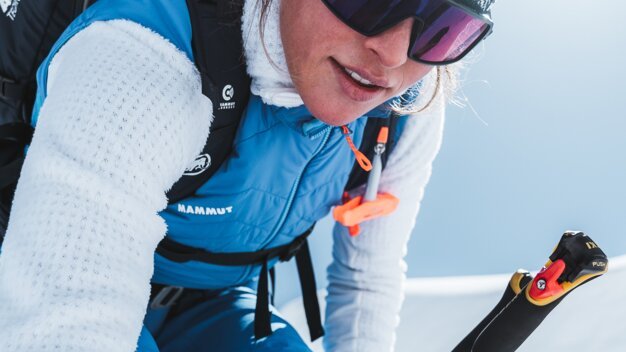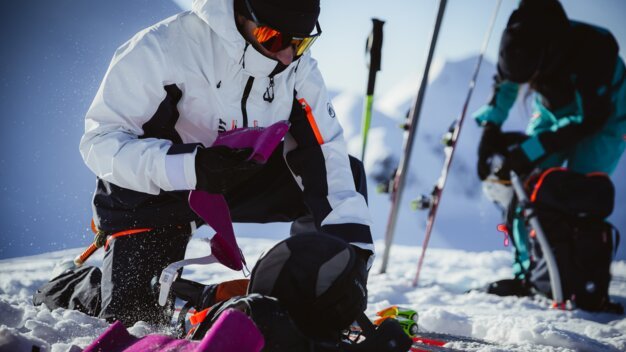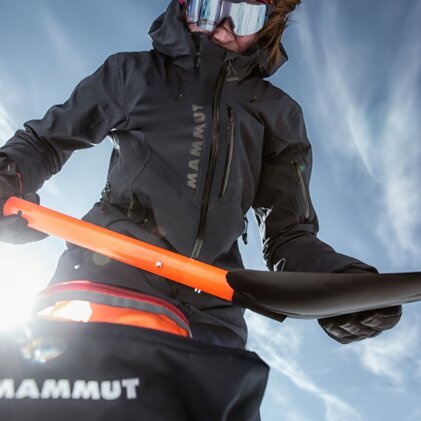
Untracked snow, pristine landscapes, no crowds, breathtaking views: There are quite a lot of benefits to backcountry skiing. However, there’s also one major downside: the risk of avalanches.
Studies have shown that avalanche airbags can significantly increase the chances of surviving an avalanche. So what should you know about these potential lifesavers? What makes a good avalanche backpack, and how does it work?
Together with the guys from Mammut, we have compiled some useful facts on avalanche backpacks and their benefits.
What is an avalanche backpack?
An avalanche backpack is a backpack with an integrated avalanche airbag system. The avalanche airbag is basically a large balloon that inflates if you pull a cord or handle. The inflated airbag will make it less likely to be completely buried by an avalanche, potentially helping you to be rescued faster.
How does an avalanche airbag work?
Most airbag systems work on the same principle. Upon activation, the airbag is filled with air from an internally attached compressed gas container. This will inflate the airbag within three seconds, giving you additional volume that will help you to keep as high up in the snowpack as possible.
Why is that? Because the avalanche airbag is built on the physical law of “inverse segregation”. It means that in an equally moving mass of particles, the smaller particles (= snow) will gravitate to the bottom while the larger ones (= you) will rise to the surface.
So it’s actually not the airbag itself that will keep you afloat in the snow – it’s your increased volume. Just imagine a box of cereals or a nut package. When you shake it, the larger raisins and nuts will gather at the top. That’s why this phenomenon is also called the “Brazil nut effect” – with you being the Brazil nut.
Thanks to this effect, an avalanche airbag like Mammut’s Flip Removable Airbag 3.0 ready can significantly increase your chances of survival in an avalanche – provided you wear and deploy it properly!
What types of avalanche airbags are there?
Essentially, you can choose between three different types of airbag systems:
integrated
- combined harness, bag and airbag system
- pack compartment has a set volume
base unit
- specific pack and harness with a built-in airbag system
- allows for compartment bags of different sizes to be zipped on
removable
- inflation system, hoses and airbag can all be removed
- can be installed in different compatible packs
In addition, avalanche airbags differ in the number of bags:
mono airbags
- inflate from top of the bag or shoulder straps
- offer better protection of the back of your head
dual airbags
- inflate from the sides
- will keep you high and flat in the debris
What’s more, there are also different types of canisters and activation units. Out tip: As far as airbag systems go, we recommend Mammut’s super reliable Airbag System 3.0. It is extremely small, lightweight and versatile, allowing you to install it in different backpacks.
How do you activate your avalanche airbag?
Every avalanche backpack works differently, so it’s important to read the product manual carefully. After all, in the event of an actual avalanche, you will have to activate the airbag as quickly and efficiently as possible.
Practicing how to activate the airbag in a controlled environment will give you a better idea of what to expect.
- How hard will you have to pull the trigger to activate the airbag?
- What will it sound like?
- How long will it take for the airbag to inflate?
That’s why it’s important to carry out regular training deployments to prepare you for the actual event. Our recommendation: Do at least one test deployment before the start of every winter season!
Fortunately, carrying out a training deployment is easy with Mammut avalanche airbags. To avoid having to refold your avalanche airbag after every practice, you can perform a test deployment without a pressure cartridge, using the provided trigger test tool.
Training deployment of a Mammut avalanche airbag
- Screw the trigger test tool all the way into the deployment mechanism.
- Put the backpack on.
- Deploy your avalanche airbag.
- Unscrew the trigger test tool from the deployment mechanism.
Travelling with an avalanche airbag
Are you planning an overseas freeride trip? Lucky you! Keep in mind though that flying with an avalanche airbag involves a bit of extra preparation.
The good news:
- In general, it’s possible to fly with all Mammut and Snowpulse avalanche airbags.
The downside:
- The pressure cartridges used in avalanche airbags are classed as hazardous goods, so special regulations apply for carrying them on a flight.
If you need more detailed information on this topic, have a look at our article on flying with an avalanche airbag.
For a more general idea, here are a few quick facts on flying with an avalanche airbag in compliance with IATA regulations:
- only 1 avalanche airbag and 1 cartridge per person
- Pressure cartridge must be filled with Class 2.2 gas.
- Pressure cartridge may not be transported separately from avalanche airbag.
- Accidental activation must be prevented.
- Airbag must be fitted with a pressure release valve.
How do you care for your avalanche airbag?
To ensure that your avalanche backpack keeps you safe for a long time to come, it takes proper care and maintenance. Here are a few useful tips for making the most of your Mammut avalanche airbag:
- Only ever clean it with water.
- Do not use solvents.
- Dry it completely before reusing it.
- Do not dry it in direct sunlight.
- Do not use a tumble dryer or heater to dry it.
Have your avalanche backpack checked
Important: If you had to use your avalanche backpack in an avalanche, have it checked by a nearby retailer or service expert!
Need to store your avalanche airbag for the summer? Simply remove the cartridge and store it together with your avalanche airbag in a cool, dry place!
What other avalanche equipment do you need?
Although an avalanche backpack can significantly increase your chances of surviving an avalanche, it does not provide any guarantees. Its effectiveness still depends on a number of other factors. That’s why you should always carry a complete set of safety equipment, consisting of …
- … an avalanche transceiver (such as Mammut’s Barryvox®)
- … an avalanche probe
- … an avalanche shovel
Don’t forget: Expertly handling your avalanche equipment takes practice. Regularly take your safety gear for training sessions and consider joining an avalanche safety course!
INTERSPORT Rent tip
If you’re a freeride newbie or unsure about safety in the mountains, we recommend dropping by at one of our many INTERSPORT Rent shops.
The RENTertainers on site know what it takes to stay safe in the mountains and will happily answer all your questions. Plus, you can choose from a vast range of rental equipment suitable for both on- and off-piste skiing.








